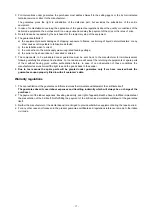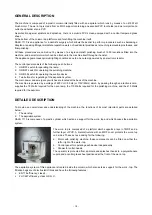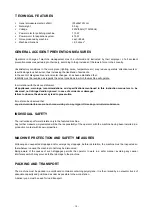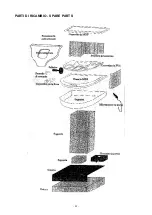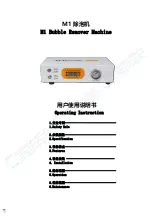
- 14 -
GENERAL SAFETY INFORMATION
All in - built accident prevention devices are to be well maintained and treated with care both in their intrinsic function and
by assigned operators who may come into casual contact with them; any tampering or failure to observe the
recommendations set out in the manual may, as a consequence, result in the equipment failing to function correctly, thus
leading to the possibility of accidents to future operators.
SAFETY MARKINGS
It is recommended that all instructions and safety markings, whether mechanical, electric, relating to accident prevention
or any other type, must be clearly visible and well maintained so that they can, in their entirety, convey the intended
message, thus preventing any possible errors which could result in accidents to the operators.
Such safety components may be in-built, if the machine’s function and position so requires.
PHYSICAL UNITS AND QUANTITIES
In order to describe physical states and phenomena, in physics and technology, physical quantities and equations are
used.
Physical quantity is accurately represented by means of the following:
1. qualitative data clarifies the quantity type, its dimensions, and its unit of measurement;
2. quantitative data indicates the numeric value.
All physical units are derived from the seven basic SI Units (the French ‘International System of Metric Units):
1. metre
(m)
length
2. second
(s)
time
3. kilogram
(kg)
mass
4. Kelvin
(K)
temperature
5. candela
(cd)
luminosity
6. ampere
(A)
electrical current
7. mole
(mol)
amount of substance
Below are some important definitions regarding electric rotary machinery:
1. Motor: a machine that converts electrical energy into mechanical energy.
2. Rating/Nominal Service: service in accordance with electrical and mechanical quantity values, together with their
duration and progression in time.
3. Nominal Power: mechanical power disposed up the output shaft in nominal service.
4. Nominal Voltage/Rated Voltage: the existing voltage, in nominal service, between the external conductors and the
terminals of the machine.
5. Efficiency: ratio of power supplied to power used.
6. Active Power: power used by the motor terminals.
7. Operating Conditions: together with the numeric values of electrical, mechanical and thermal quantities, these are
determined according to the mechanical charge applied to the motor.
8. Open circuit operation/No load operation: operation of the motor at the nominal voltage and frequency without load.
9. Service: series of operating conditions, with their duration and sequence order in a determinate time, including rest
periods and periods of no load operation.
10. Service Type/Mode: estimated service, comprising one or more operating conditions.
11. Intermittence Ratio: percentage between loaded operation duration, including the electric starting and stopping
processes, and the cycle duration.
12. Cycle Duration: for types of service, in which various operating conditions are periodically repeated, the cycle
duration is the duration of that period.
13. Thermal Equilibrium: the state reached when the excessive temperatures taken in different parts of the machine do
not vary more than 2 K in an hour.
Содержание 1100
Страница 22: ...22 SCHEMA ELETTRICO ELECTRIC PLANT Electrical drawing...
Страница 23: ...23 PARTI DI RICAMBIO SPARE PARTS...

















